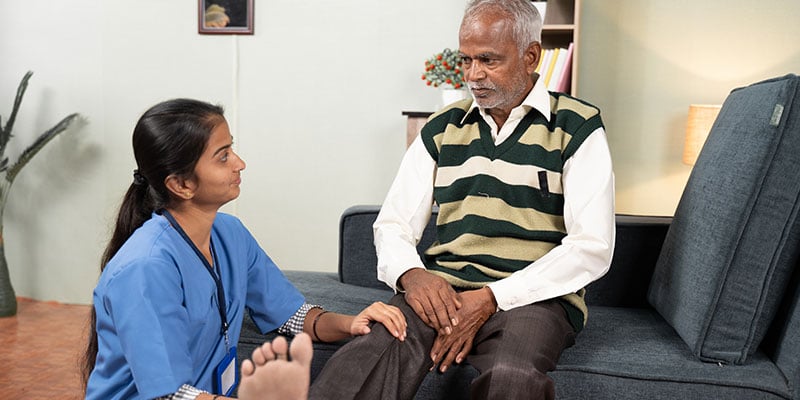
Parkinson's disease is a chronic degenerative brain disease that commonly affects older adults. It is the second most common brain disease in today's scenario, restricting the brain from functioning properly. Patients with Parkinson's disease have balancing challenges as the disease impacts the part of the brain that controls body movements. Thus, the most common risk involved with Parkinson's is falling and developing injuries. We live in a world with highly advanced medical technology, yet the bitter truth is that there is no cure for Parkinson's disease. However, a few treatments are helpful in relieving the symptoms. Physical therapy for Parkinson disease is a popular method to ease the difficulty of improper brain functioning. When physical therapies are combined with medications, it improves balance, increases mobility, strengthens muscles, and develops coordination.
The Most Common Symptoms of Parkinson's Disease
The brain has a particular set of nerve cells that produce dopamine. This brain chemical helps in controlling the body movements, balance, behaviours, moods, and thought processes. Parkinson's disease is due to the loss of these nerve cells responsible for creating dopamine. The symptoms are divided into motor and non-motor, and both get worse with time. The severity of the symptoms varies from one patient to another. The common motor symptoms that a Parkinson's patient experiences include:
- Body tremors
- Muscle rigidity
- Coordination difficulty
- Shuffled walking
- Fewer arm swings while walking
- Smaller movements
- Stiff muscles
- Neck, shoulders, and trunk discomfort
- Postural instability
- Poor body balance
- Stooped posture
- Falling risks
- Slow body movements while showering, dressing, etc.
- Having a frozen feeling in the feet, making it difficult to turn around or take the first step while walking
- Swallowing difficulties
- Speaking difficulty
- Difficulty with facial expression
- Incontinence
The non-motor symptoms are:
- Fatigue
- Depression
- Lightheadedness
- Lack of motivation
- Anxiety
- Difficulty paying attention for a long duration
- Disturbed sleep
How Can Physical Therapy Help Parkinson's Disease?
Physical therapy is an essential treatment for patients with Parkinson's disease. It helps patients lead a comfortable life by improving symptoms that are related to motor skills. It does not have any side effects on the body as they are exercises to enhance and regain the system's functionality. Research states that increasing the physical activity in patients by 2.5 hours a week will help maintain their quality of life. Thus, physical therapy is a must-have for every patient diagnosed with Parkinson's disease. The ways in which physical therapy aids in treating the symptoms of Parkinson's are:
- Correcting the abnormal movement patterns.
- Improving posture.
- Maximizing muscle strength.
- Increasing joint flexibility.
- Maintaining independence to improve the quality of life.
- Develop the level of body functioning.
- Enhancing the effects of medicines.
- Regularizing the breathing pattern.
- Reducing foot freezing episodes.
- Enabling endurance and mobility.
- Minimizing the risk of falls.
Role of a Physical Therapist
Physical therapists take the responsibility of educating the family members and caretakers of the patients. They evaluate joint and muscle pain and plan exercises and everyday tasks for patients. Exercises induce neuroplasticity which is the ability of the brain to respond to behavioural changes. With the onset of physical therapy, the brain learns to think in new ways and treats symptoms like anxiety, fatigue, and depression. In simple words, physical therapy slows down the progression of the disease.
The role of a physical therapist in treating Parkinson's disease is to design an exercise routine that targets motor impairments. After a comprehensive evaluation which examines strength, posture, flexibility, endurance, coordination, and balance, therapists formulate a diagnosis and develop a personalized treatment plan for patients. Based on the test results, they proceed with the treatment plan to make the patient independent with the right exercise.
Types of Physical Therapy for Parkinson's Disease
The basic role of physical therapy in patients with Parkinson's is to enhance the ability to move. However, the type of physical therapy for a patient depends on the severity of the symptoms and their needs. A few of the common physical therapies for Parkinson's disease are:
Amplitude Training
Physical therapy used to retrain muscles is called amplitude training. This therapy slows down the progression of conditions like bradykinesia and hypokinesia. Bradykinesia is the slowing down of movements, whereas hypokinesia is the occurrence of shuffling movements. Amplitude training helps patients make elaborate movements like swinging their arms and taking huge steps.
Reciprocal Movements
Parkinson's disease impairs the ability of a person to perform reciprocal movements, thereby causing balancing issues. Reciprocal movements are those that happen in the body involuntarily in opposite directions at the same time. A classic example of reciprocal movement is the arms swinging while walking. Physical therapies used to reinforce the reciprocal patterns use a stationary bike and elliptical machine. Elliptical machines help with the movements of legs and arms, whereas a recumbent bicycle works the lower part of the body effectively in a reclined position. When the patients have no access to exercising machines, they must be encouraged to walk indoors swinging their arms.
Balance Training
The brain is the organ that keeps the body's balance by using the input from the ears, eyes, joints, and muscles. Parkinson's disease affects the balance system, causing instability while walking, thereby causing a fear in the patient to go to a public area. Balance training helps in preventing unnecessary falls and improves the patient's gait.
Stretching
Parkinson's patients experience a stiff and tight hamstring, calf muscle, and hip flexor. Stretching exercises at frequent intervals help in counteracting the stiffness. They improve flexibility in the body, and the recommended stretching routines which target areas like calves, lower back, chest wall, neck, shoulders, elbows, hamstrings, knees, wrists, and palms. When a patient makes it clear to the physical therapist about the areas experiencing stiffness, the therapist takes the initiative to improve flexibility in those muscles. Eventually, flexibility exercises enhance activities like lifting, bending, and walking.
Strength Training
It is natural for muscles to weaken and age. But for patients with Parkinson's disease the muscles grow weaker with time. Strength training is provided for patients depending on the stage of the disease and the patient's age. Physical therapists will suggest resistance exercises with either resistance bands or light dumbbells. Water-based exercises are strength training activities to increase endurance, improve motor symptoms and strengthen muscles. Exercises in strength training target triceps, thigh muscles, buttocks, and core muscles.
Dual-task Practice
Parkinson's disease makes everyday activities difficult for patients as they find it challenging to perform multi-tasking activities. Since they may find it hard to switch from one task to another, physical therapists offer two activities at the same time and train patients to overcome this symptom. Thus, dual-task practices retrain the brain to tackle two tasks simultaneously and also enhance balancing skills. Some popular dual-task practices are bouncing a ball and walking while counting.
Closing Remarks
Physical therapy will target the symptoms with the right exercises and make a patient feel better. Doctors suggest starting with physical therapy in patients diagnosed with Parkinson's, even if they do not have pain or mobility issues. The earlier the patients start the physical therapy, the sooner they will achieve their goals and delay disease progression. The most efficient and experienced therapists work at Hamsa center in Chennai to provide physical therapy to Parkinson's patients to treat any stage of this disease.












